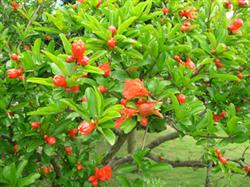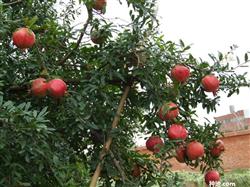How to plant pomegranate trees for high yield

How can pomegranate trees be planted with high yield? Please introduce pomegranate flowers and fruits, juicy and delicious, with rich nutritional value and medicinal value. In addition to fresh food, it can also be processed into fruit juice, fruit wine and so on. The cultivation techniques of short, dense and early high yield of pomegranate are introduced as follows: first, build garden 1, deep ploughing and soil preparation. Before October 30th, the garden was cleaned up, the roots of the old trees were removed, and the preliminary leveling was carried out. 4000 kg of high-quality farm manure was applied per mu, followed by flood irrigation. After the water dries, the machine turns deeply, the depth is about 25 centimeters. 2. Ditching and ridging, digging and planting pits. According to the strip field to the east-west direction of the ditch, the ditch depth of 20 cm below the ground level, the upper mouth width of 1.2 meters, for the wide mouth flat bottom ditch. After the trench is completed, dig a planting pit on the sunny side of the ditch bottom, with a depth of 60 cm and a diameter of 80 cm. The topsoil and subsoil are stacked separately, and 20 cm thick of rotten farm manure is applied at the bottom of the pit, and then 20 cm thick topsoil is filled and irrigated. The seedlings are planted when the moisture is suitable for infiltration under water. 3. Seedling selection. Seedlings with intact root system, no major trauma, high degree of Lignification of stem, dense needlelike branches (short internodes) and more hairs on stem were selected for planting. The diameter of the base of the seedling is not less than 0.8 cm and the height is not less than 80 cm. 4. Seedling planting. Clean the prepared planting pit a little, then backfill the appropriate soil moisture topsoil 5 cm thick, and put it into the seedlings. Still use suitable soil moisture topsoil backfill, while burying pier seedlings. It should be noted that the seedlings should be tilted 70 °to the sunny side when planting to facilitate burying the soil. After planting, step on the fill, pile a 10 cm high "soil pillow" at the inclined base of the seedling, press and bend the seedling base on the soil pillow, and then bury the seedling up to 40 cm thick with suitable soil moisture soil, so as to prevent the seedling from cold and survive the winter. If there is plenty of time, it can also be watered immediately after planting seedlings, and after the water is dry, bury the soil in accordance with the above method to survive the winter. The soil moisture should be 70%. Second, management in spring and summer of that year. 1. Open piers and release seedlings. The time of opening pier and releasing seedlings should not be too early, and it is suitable for late April. It is forbidden to discharge water in the ditch before opening the pier, and be careful not to disturb the seedlings when opening the pier. Planing the mound and leveling the surface at the bottom of the ditch, watering immediately after cleaning the planting ditch. 2. Set dry. Pomegranate is a shrub, because it wants to bury the soil for the winter, the height of the fixed stem should not be too high. It is generally dry at 10 cm from the base, and the cut is wrapped with plastic film. 3. Shaping and pruning. The clump happy tree is used. After the seedlings are dried, new branches sprout from the base. 3-5 new branches with exuberant and balanced growth were reserved as main branches, and the rest were erased. When the new branch grows to 60 cm high, the angle of the new branch is 70 °, and the inward growing shoots are thinned at the same time. The distance between the main branches was evenly divided by 360 °. 4. Fertilizer and water management. The seedlings are watered once after opening the pier, and the planing plate is loosened after the water is dry to remove weeds in the ditch. Under some conditions, the tree plate can be covered with plastic film after opening the pier, so as to increase the ground temperature and help to sprout earlier. Loosen the soil planer 3-4 times throughout the year. When the new shoot grows to about 20 cm, the plant applies 50-100 grams of urea and fertilizes 3-4 times a year. After that, the application of phosphorus and potassium fertilizer was increased twice. Water control and fertilizer control from late August to late September. After a year of growth, the newly planted seedlings can cultivate 3-6 main branches with a height of 80 cm and a thickness of 0.8 cm. 5. Crop selection in the same year. Planting tall crops in pomegranate dense planting orchard is strictly prohibited, and dwarf tomatoes, potatoes, mung beans, sweet potatoes and other crops are selected. Autumn crops can only be soybeans, mung beans, dwarf tomatoes, should not grow winter cabbage, winter radish and other late crops that need big fertilizer and water. Third, the management of autumn and winter in that year. 1. Fertilization and watering. In August and September, fertilizer and water should be controlled to facilitate the full Lignification of branches. After late September, the soil was watered once according to the dry and wet condition of the soil until it was irrigated in winter. The selection of winter irrigation is carried out in late November, and it is most suitable when the water seeps rapidly after irrigation and the topsoil is not frozen. About 10 kg of farm manure was applied to the plant before defoliation, and a ring-shaped ditch or furrow was opened outside the crown to fertilize and bury the soil. After applying fertilizer, winter water is watered at the above time. 2. Bury the ground to survive the winter. According to the method of burying the soil last autumn, each main branch should be buried slightly thicker at the base of the crown according to the direction of pulling the branches. Fourth, the following spring and summer management 1, pier opening. After opening the pier, the main branch was propped up with a bracket at 70 °, and the auxiliary shoots on some of the main branches began to blossom and bear fruit. 2. Strengthen summer pruning. Remove all the sprouting new shoots from the base and the sprouting shoots less than 30 cm from the main branches, and remove the dense branches and inner bore branches. Because the dry nature of pomegranate is not strong, it is easy to give birth to lateral tips, so it is generally not necessary to pick the heart. Management of the following autumn and winter and the third year 1. By autumn and winter, the crown width can reach about 1-1.5 meters, repeating the previous year's field management work. However, the amount of basic fertilizer applied to farmers should be gradually increased to 20 kg / plant. The burying method is the same as that of the previous year. 2. In the third year, repeat the previous year's field management work: opening piers, clearing ditches, top branches, removing moldy and damaged branches, removing sprouting, preventing insects (summer aphids), and thinning branches. Click to get more pomegranate planting techniques click to get more fruit planting techniques
- Prev

Why can't you hang the fruit after the pomegranate blossoms?
Why can't you hang the fruit after the pomegranate blossoms? There are three reasons why pomegranate can not hold fruit after blooming: first, during its vegetative growth and flowering period. Lack of light or coincides with overcast and rainy weather; lack of light will cause plant vegetative growth to be relatively prosperous, which is not conducive to the accumulation of nutrients in the body.
- Next

What are the common pests of pomegranate trees
What are the common pests of pomegranate trees? Please introduce the following kinds of pomegranate pests: Japanese tortoise wax scale, commonly known as scale insects, belonging to Homoptera, Coccidae. The nymph absorbs sap on leaves or shoots and secretes mucus, which induces coal fouling, affects photosynthesis, weakens the tree, and causes a large number of fallen leaves and fruits.
Related
- Moge, come on! The staff of the peasant association in the producing area of cantaloupe were frightened when the crowd gathered.
- Causes and Solutions of low Fruit setting rate of Apple
- Symptoms and control measures of passion fruit virus disease
- Fruit growing lesson: how do apple orchards keep high yields?
- Can you build orchards in the mountains? What are the pros and cons?
- How to manage the coloring period of Crisson grape?
- This paper introduces the processing technology of two kinds of fig products.
- How much is a month for retired teachers in rural areas by 2020?
- How can strawberry planting increase sugar content? We should pay attention to management in many aspects.
- What are the cultivation techniques on how to improve the yield of golden fruit?

